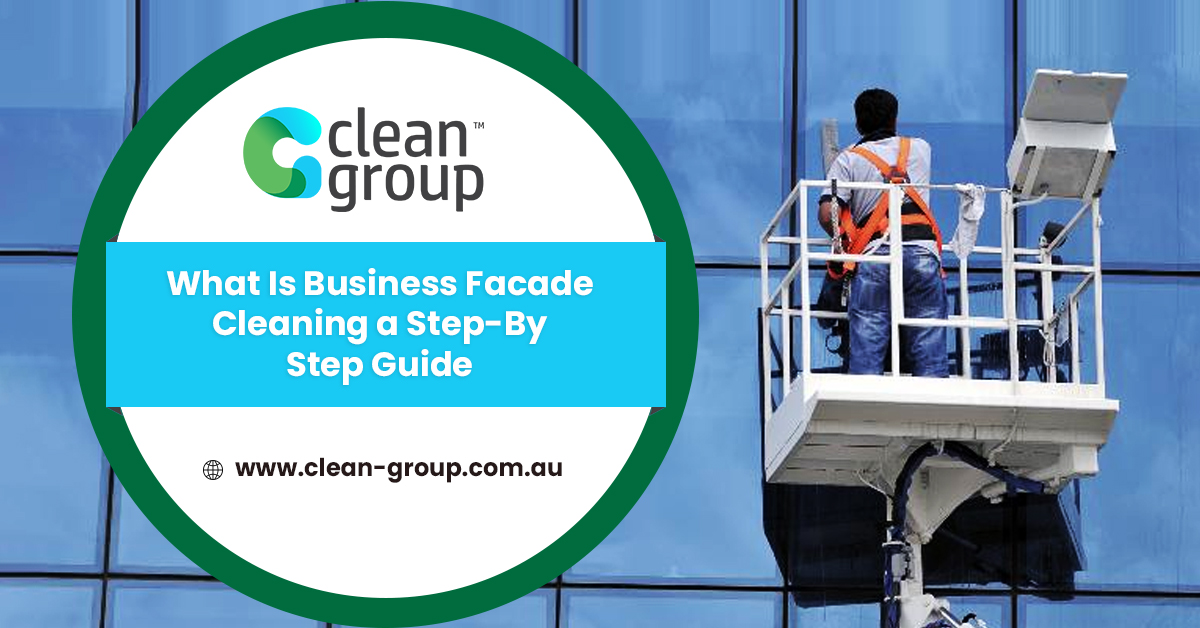As important as it is to keep the inside of a commercial building clean and well-maintained, it is equally important to not miss the exterior, that is the front and the sides of the building. Many modern buildings have an artificial front, called a facade, which is generally used to give a designer appeal to the building. Regular commercial cleaning and maintenance of building facades are important, but it’s easier said than done. Facades are generally the designer and more complex part of the building.
Understanding and timing a facade cleaning job can be difficult for many reasons. Moreover, choosing the right cleaning process and personnel is crucial because unprofessional cleaners can end up doing more harm than good.
Read here about the best professional approach to cleaning a commercial facade.
Why Clean Facades
A facade is the exterior or front of a building. It’s the first thing that the visitors of the facility will see. A clean and well-maintained facade will not only make the commercial building look appealing but also ensure a long life for the building material.
Building facades are usually made of stone, wood, and glass, and may sometimes contain aluminium or other metals. All these building materials will start accumulating dirt, grime and stains over time and without routine cleaning.
Since a facade is the outermost part of a building, it faces everything from the weather to pollutants, air, dirt, and so on. All these things can affect both the quality and color of the facade, making the building look bad with time.
That is, the building facade will start losing its appeal if not cleaned and maintained properly. And people generally prefer to visit a building that is more aesthetically pleasing rather than a dirty or poorly maintained one.
Those who are serious about keeping their Sydney business prospering and want more customers for the business must focus more on maintaining a clean and fresh-looking facade.
A clean facade is also known to help impress passers-by and may inspire more of them to enter the premises. A poorly maintained entrance, on the other hand, can adversely impact the business reputation and turn the customer away.
For renters, their rental agreement may require them to keep the building exterior well-maintained, so it’s important to regularly clean the building facades.
Things to Know
How a facade should be cleaned will depend on a number of things, including the type of the building, the material used in the facade, and the building’s location, among others.
Cleaning a facade can be more complex than general cleaning or other regular types of cleaning. For example, one would need to know about and have access to the right cleaning equipment and solutions
Depending on the building type, cleaning a facade may also involve working at heights, which is why it’s important to take proper precautions and use the correct safety gear. If not sure, hire a professional facade cleaner for the job.
The primary purpose of facade cleaning is to prevent dirt build-up, which may react with the material and reduce the facade lifespan. Having a keen eye to identify such areas where dirt might build-up is crucial for effective facade cleaning.
Some other things to consider when starting to professionally clean a building’s exterior/facade.
- The cleaning goals and expected results
- What part of the building the cleaner needs to focus more on
- The impact on the environment (wind, rain, etc.)
- The right cleaning approach based on the property type and size
- Maintaining the safety of building users during cleaning
- Possible disruptions
- Access to water supply for cleaning/washing
- Do it all at once or clean in phases?
How to Clean a Commercial Facade – a Step-By-Step Guide
As mentioned earlier, before starting to clean a commercial property facade, it is important to find the right tools and supplies for the job, which will depend on the type of the building and the facade as well as the material used in building the facade. Since stone, glass and wood are the most widely used facade materials, we will discuss the facade cleaning process in reference to these three materials.
Step 1: Choosing the correct equipment & solutions for building facade cleaning
To clean the building exterior, including the front, selecting the right tools is the much-needed first step. A professional commercial cleaning company would know the best facade cleaning equipment for different building types and facade materials as well as have access to the latest cleaning tools for the job.
Some of the tools and equipment needed for facade cleaning are pressure washers, detergent, squeegees, microfibre cloths, sponge brushes, soft-bristled brushes, water buckets, spray bottles, glass scrapers, towels, tool belts, etc. Cleaning of high-rise building facades may require additional & advanced equipment and tools such as bosun’s chair, tool belt, safety belt, movable platform, and others.
Different facade materials will need different types of cleaning solutions. For example, basic, natural detergents can be used for the cleaning of glass, bricks, stone, etc. Using high-level, chemical-based cleaners are not recommended for cleaning wooden facades.
Dish soap with warm water is generally the best and safest solution for wooden facade cleaning. To remove oily and other sticky stains from glass, one may consider using acetone or isopropyl alcohol on the affected areas.
Before starting the facade cleaning job, make sure to have all the necessary equipment and resources handy.
Step 2: The cleaning checklist
Having a cleaning checklist can both ease the job and save a lot of time in facade cleaning.
A cleaning checklist is nothing but a list of the tasks that one is going to perform during a cleaning job. A commercial facade cleaning checklist may include the following things:
- Sweep all debris, dust, and dirt from near the building door, sidewalks and parking
- Clean the main door
- Wash off the porch
- Clean and replace welcome mats
- Clean interior window glass
- Clean or wipe glass doors to remove dirt and streak
- Wash window sills and tracks
- Repair walkways if needed
- Repaint the door if needed
- Remove and clean window screens
- Check walls, siding and foundation for signs of tear
- Clean, dust or wash walls as needed
- Wash porch ceilings and floors
- Clean and insert storm windows
- Clean debris
- Repair or replace broken bricks
- Check for leaks and cracks
- Clean gutters. Repairs holes and damage if any
- Wipe clean glass doors and frames
- Clean exterior window glass
- Empty and clean outdoor trash cans
- Clean the parking lot and remove any leaves or debris
A professional facade cleaning company like Clean Group will have its own cleaning checklist to help ensure a fast and efficient process.
Step 3: Facade Cleaning Methods
Depending on the type of building, its size and the materials used in the facade, two of the most common types of facade cleaning methods are water-based cleanings and chemical cleaning.
Water-based facade cleaning
As the name suggests, these methods involve the use of water to clean a facade. Using water to clean a building’s exterior is one of the simplest and oldest methods.
Depending on the water-based cleaning method, one might need a few resources & equipment besides access to a water supply source. Water-based facade cleaning methods can be further divided into three the following three types, depending on the cleaning equipment and process:
- Pressure washing
- Soaking
- Steam washing
Pressure washing is the most commonly used building cleaning method. A spraying machine is used to spray the building exterior with a medium/high-pressure water stream in order to remove dirt, grime, and stains from the walls and surfaces.
A soft-bristled brush can be used to remove stubborn stains stuck in tricky areas and corners. To remove oil and other stains, a detergent or soap solution may also be used.
Soaking is a cleaning method that involves letting certain areas soak in light water spray for a few hours or days in order to loosen stubborn stains and soot. The areas are then cleaned using a brush or microfibre cloth.
Steam washing involves the use of hot water with pressure washing equipment to remove heavy dirt, soil, etc. from buildings. This is particularly recommended for stone cleaning where chemicals are not safe to use.
Chemical Facade Cleaning
As the name suggests, this type of facade cleaning method involves the use of chemical-based cleaners. These are generally more effective in removing oil, paint and other stains and can also remove deep-stuck dirt from building walls. Chemical cleaners are applied to the stains or affected areas and may take a few minutes to work. After that, they are cleaned off with water.
Alkaline cleaners are suitable for use on limestone, marble and similar types of stone buildings. They are less severe and can remove a variety of stains without harming the stone.
Acid-based cleaners are more severe and must only be used for cleaning concrete, granite and unglazed brick walls.
Harsh chemicals are not generally suitable for use on glass. Consult with a professional before trying.
Step 4: Facade Cleaning by material
Glass cleaning
To clean glass windows or doors on the exterior, mix water with a natural detergent. Use a soft brush or squeegee to gently apply the cleaning solution to the glass facade. Let it sit for a couple of minutes, then rinse with water. To remove oil and other stains, non-toxic chemicals like isopropyl alcohol or acetone can be used.
Stone cleaning
To clean the stone parts in the facade, use a water-soap solution. Mix warm water with dish soap to prepare the solution. Use a soft-bristled brush to clean the affected areas of stone with the solution. Rinse with clean water.
Cleaning wood facades
Woods are relatively more sensitive than stone or glass and must therefore be cleaned carefully. First, remove any moss or dirt from the facade using a clean cloth. If there are stains or sticky dirt on the wood, use warm water & dish soap solution to gently remove it. Rinse with clean water.
Hire Professionals for Facade Cleaning
Facade cleaning can be troublesome and time-consuming, especially if the person does not have any experience in it. Hiring a professional commercial facade cleaning company can save both trouble and time. Moreover, an expert commercial cleaner will have the resources and expertise to professionally clean a facade without causing any harm.

